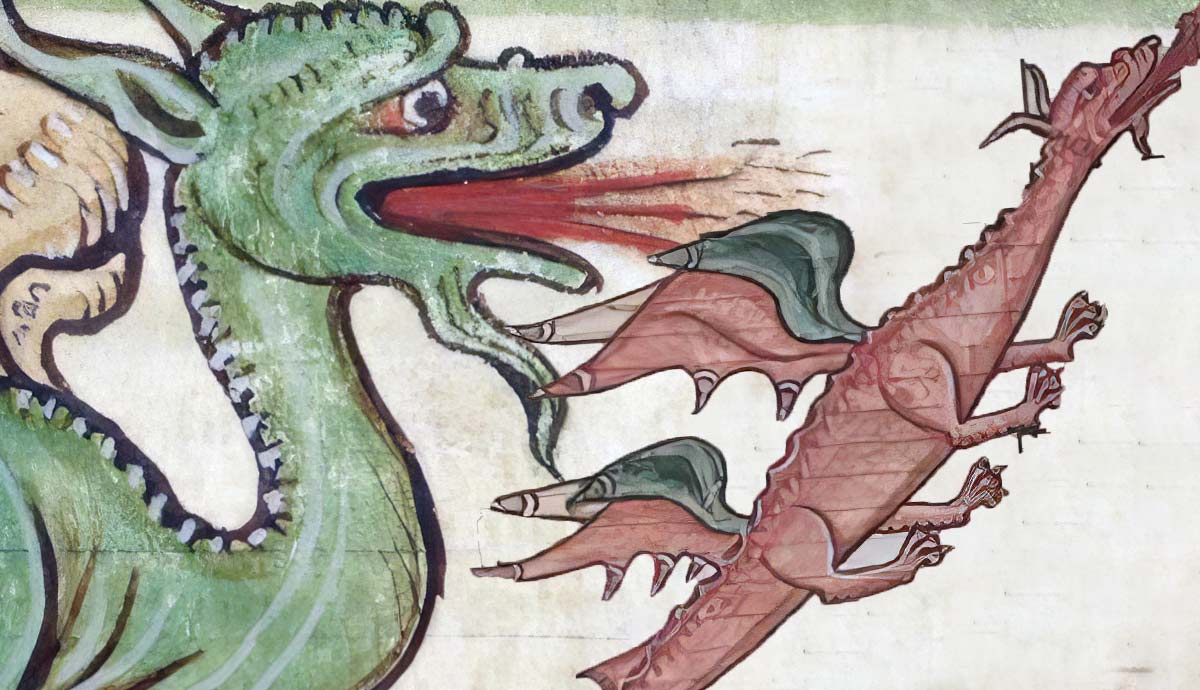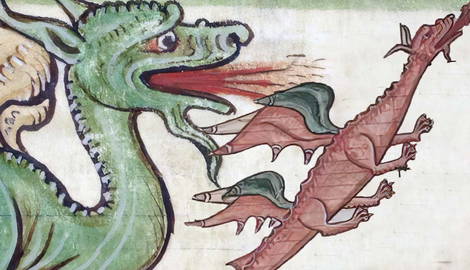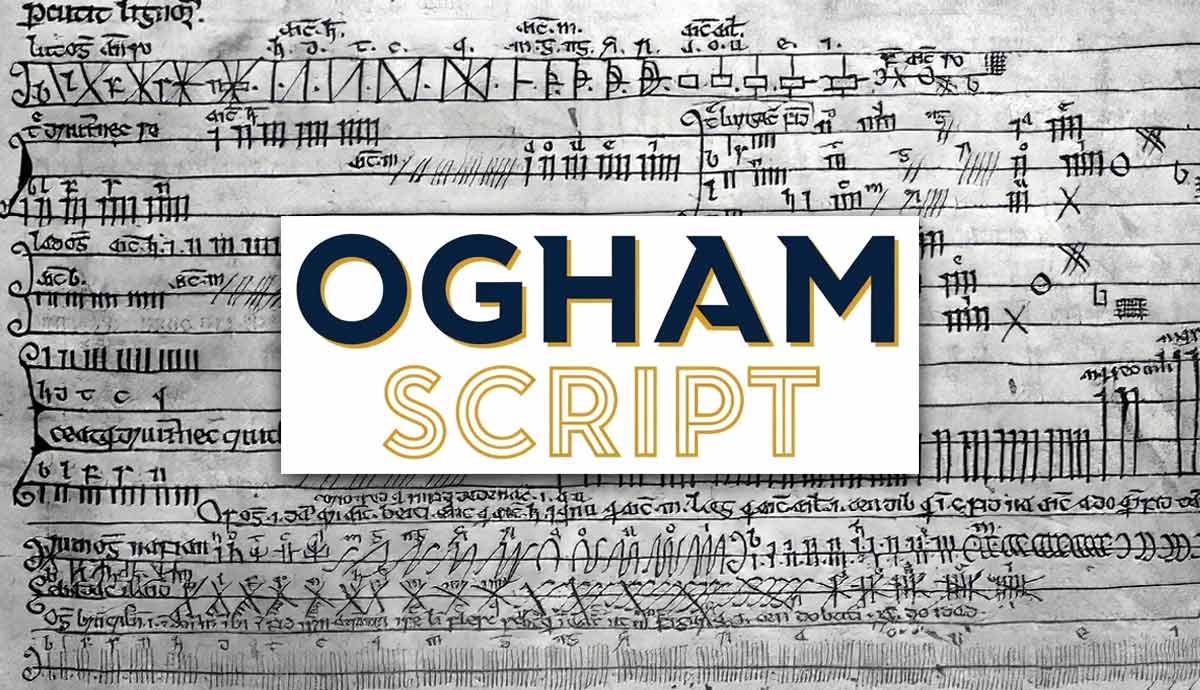
Dragons were thought to be real beasts up until as late as the 18th century. Knowing that they are creatures of myth now, it is curious that they were so prevalent in medieval art and storytelling. They were particularly popular in English art and literature and were the famous opponents of characters like Beowulf and St. George. This article will break down precisely what dragons symbolized in the early medieval world, how visual culture and literature reveal the English understanding of the dragon, and how the iconography of the dragon developed in the later Medieval and Early Modern periods.
The Early Medieval Dragon: What Was It?

The early medieval dragon had overwhelmingly negative connotations when it was referenced in stories and art. Though it was thought to be a real creature, it seems to have largely only been referenced in literature symbolically. In Old English “dragon,” “serpent,” and “worm” seem to have been almost interchangeable terminology, with dragons referenced using the terms “draca” or “wyrm.”
Their dragons look much like our contemporary understanding of a dragon: it was winged, with a large, reptilian body, a tail, talons, fanged teeth, and it often had horns. Some dragons are depicted with scaly bodies, others with feathers, and some were shown with beards. Most depictions of dragons from this period seem to have gone back and forth between an understanding of the dragon as a reptilian monster and as a bird-adjacent creature because of its wings. Naturally, no depiction of a dragon could have been based on an artist’s experience of one.
It was said that a dragon’s strength was in its tail, not its teeth, and that a dragon’s venom was harmless. Rather, anything a dragon caught it would kill in the coils of its tail. Dragons were said to be the enemies of elephants, but they also could not stand the smell of a panther’s breath and would hide from a panther’s roar. Generally, dragons were thought to live in India and Ethiopia. It is curious, then, that they are prominent figures from Germanic mythology and Old English literature.
Dragons in Other Parts of the Medieval World

Though predominant in Germanic mythology, dragons were also figures in mythology from around the globe. For example, the dragon was the most frequently represented beast in the medieval Muslim world. In this context the dragon had a multivalent, antithetical meaning: it represented both good and evil, order and chaos, the divine and the satanic, blessings and destruction.
Arab variations of the dragon were heavily influenced by ancient Mesopotamian mythology, as well as Central Asian and Persian sources. Most Central Asian stories about dragons portray them as powerful but positive beasts, while Persian sources portray them as evil. In the eastern part of the Islamic world, the dragon is traditionally viewed as good, and in the western part, the dragon is considered threatening and evil.
A prominent dragon in Ethiopian mythology is the Arwe (“wild beast” in Ge’ez), a snake king who ruled for 400 years over the land that was to become Ethiopia. Arwe reigned through terror, demanding human sacrifices. In this myth, the dragon therefore unequivocally has a negative connotation. Ultimately, however, Ethiopia is born from the defeat of Arwe, which does have a positive connotation.
Dragons have a long history in Chinese visual culture. Images of dragons in Chinese art can be traced as far back as the Neolithic Period, as well as to the Han Dynasty (206 BCE-220 CE). Dragons were believed to be the divine rulers of moving water, residing in rivers and oceans. They had the ability to control the weather and to bring rain, which in turn brought life, prosperity, and fertility. They were also symbols of power, strength, and imperial majesty. The dragon, therefore, had a very positive connotation in Chinese culture.
The Dragon in Old English Literature

The dragon appears throughout various poems and texts in Old English literature. Maxims II, a piece of Old English gnomic poetry, offers a description of dragons, stating: “draca sceal on hlæwe, / frod, frætwum wlanc” — “the dragon will be in the barrow, old, proud in adornments,” (lines 26–7). This subterranean dragon, concealed in its mound, is the same kind of dragon found in Beowulf, where it is referred to as a hoard-guardian on four occasions.
The dragon in Beowulf is the earliest example of a traditional European dragon, and according to the narrator, inhabits a “hord on hrusan þær he hæðen gold / warað wintrum frod; ne byð him wihte ðy sel” — “a hoard in the earth where, old in winters, he guards heathen gold. It does him not a bit the better,” (lines 2276–7). In this context, the dragon’s association with the hoard is strengthened, and therefore its association with greed.

The dragon in Beowulf is connected to the trope of hoarding, as evidenced by the quote above. Hoards, during the Early Medieval Period, were often full of treasure. “Hoard” is an archaeological term for a deposit of valuable objects, sometimes intentionally buried, and often originally belonging to a wealthy individual. Dragons being possessive over their hoards of treasure may reflect greed but could also be seen as a very real analogy for the early English kings, princes, and other elite members of society who were buried with their own hoards of treasure.
Interestingly, Beowulf’s encounter with the dragon is aligned with his encounters as a Geat with the Swedes and the Frisians. Just as the dragon could be aligned with the elite Angles and Saxons in the context of the poem’s popularity in Old English oral tradition, so too could it be seen as a metaphor for internal struggle and the eventual fall of the Geats to the Swedes.
The Dragon in Early English Art

The dragon could take on a somewhat subverted meaning when utilized in early English artwork. Many examples of the dragon in artwork are from illuminations in manuscripts. Other examples, however, include ornate, metalwork objects.
The dragon is shown above on the original Sutton Hoo helmet, which was found in the Sutton Hoo ship burial in 1939. The burial was from the kingdom of East Anglia and likely belonged to an East Anglian king, due to the high quality of craftsmanship reflected in the objects buried within, and the number of objects from faraway lands included in the hoard. Scholars are not certain who was buried at Sutton Hoo, though the prevailing theory is that it was Rædwald, a king who died in 624. Regardless of whether the individual buried in the famous ship burial was Rædwald or not, the owner of the objects in the ship was certainly an elite, powerful person.
The elite nature of the Sutton Hoo ship burial’s occupant is revealed in the objects within, and especially on the Sutton Hoo helmet. A few objects, like the helmet, the Sutton Hoo belt buckle, a purse lid, and a pair of shoulder clasps, are all believed to have been the handiwork of a local craftsman. That they were locally produced indicates that they were commissioned as goods specifically for their owner, and that they were likely intended to signify things about the owner to his audience if he were to wear them.
The helmet likely would have been worn as a piece of ceremonial regalia, rather than for practical use in battle. The dragon’s prominent position on the front of the helmet indicates that it was meant to be seen by an audience.

If the wearer of the helmet wanted the dragon to be seen on his face, what did it mean? In this context, the dragon probably symbolized power, strength, and wealth. By using a beast typically associated with extreme strength the king could indicate to his constituents (and to his enemies) that he was a force to be reckoned with.
The dragon, however, is also associated with cunning and treasure. The wearer could therefore be signifying not only physical strength but mental strength and material wealth. This visual significance made dragons and serpents popular motifs in early English metalwork.
Dragons in English Myths and Legends

A common medieval trope was the dragon as the nemesis of a saint or angel. In addition to epic poems like Beowulf, which cast the dragon as a formidable foe for a hero character, later medieval texts likened the dragon even more to the Devil. Many illuminated manuscripts feature stories involving figures like St. George, St. Margaret, and the Archangel Michael facing off against dragons.
St. George’s story, in particular, might be one of the most famous English legends. George is thought to have been born into a noble Christian family in the third century in what is now Turkey, and he was martyred in 303 CE after refusing to persecute his fellow Christians.
St. George’s story was brought back to England by Crusaders during the Middle Ages. The legend states that a dragon was terrorizing a local village when George arrived. The King had decreed that the village must begin sacrificing children to appease the dragon. A child was chosen by lottery each day, until one day the King’s daughter was selected. George arrived at the scene as the King’s daughter was being led to the dragon, and he stepped up to battle the dragon and successfully slayed it.
King Edward III made St. George the patron saint of England in the early 14th century. Though St. George was not originally from England, he was chosen as a patron saint because of his courage and strength in adversity, and his dedication to the pursuit of good over evil.

St. George’s story was not the only one that would have been known in England at this time. The story of St. Margaret is also depicted in medieval English illuminated manuscripts. Like St. George, Margaret was from Antioch, in what is now Turkey. She was raised as a Christian by her nurse. When she turned 15, a Roman soldier named Olybrius wanted her to renounce her faith and marry him. She refused, and he imprisoned her. She was tortured in prison, and her legend says that the Devil appeared to Margaret in the form of a dragon and swallowed her whole. She either made the sign of the cross or had a cross with her in the belly of the beast, and she was freed. She was canonized for her devout faith.
The Development of Dragon Iconography Over Time

The symbolic significance of the dragon shifted between representing good and evil over the course of the Middle Ages. In the Early Middle Ages, as discussed above, the dragon was often associated with the Devil, chaos, greed, evil, and fear. It served as an opponent to traditionally “good” characters, like the hero Beowulf or saints like George and Margaret.
While the dragon carried some of these negative connotations with it into the later Middle Ages, it took on some positive connotations as well. Dragons were used in discussions of astronomy and natural history and were used as decoration to symbolize strength — like that on the Sutton Hoo helmet and even within the Tudor coat of arms.
A dragon forms the body of the Draco constellation, which has held various meanings for different peoples and their mythologies across the globe. While some myths, like the Greek myths of Hercules, portrayed the dragon as an enemy yet again, Celtic mythology associated the Draco constellation with the dragon Cadarn, who was considered a symbol of nature and cosmic order.

The Tudor Dragon, meanwhile, was adopted as a symbol by all the Tudor monarchs in England as a reference to their Welsh heritage. The Tudor Dragon is a ferocious beast — signifying power, strength, and courage to anyone who might look upon it. In this way, the Tudor Dragon embodies the qualities of the dragon that are reflected in the Sutton Hoo helmet.
Henry VIII claimed the symbol as a link to Cadwaladr, the king of Gwynedd in Wales from 655-682. The red Tudor Dragon similarly appears on the Welsh flag as the red dragon of Cadwaladr, after the Welsh first adopted the use of the dragon as a symbol of strength in the fifth century after the Romans withdrew from Britain.
Bibliography
DuBois, A. E. (1957). The Dragon in Beowulf. PMLA, 72(5), 819–822.
McEwan, D. (2007). Sebetat: the Many Lives and Deaths of a Monster. Journal of Ethiopian Studies, 40(1/2), 101–125.
Symons, V. (2015). Wreoþenhilt ond wyrmfah: Confronting Serpents in Beowulf and Beyond. In M. Bintley and T. Williams (Eds.), Representing Beasts in Early Medieval England and Scandinavia (pp. 73-93). Boydell and Brewer.










